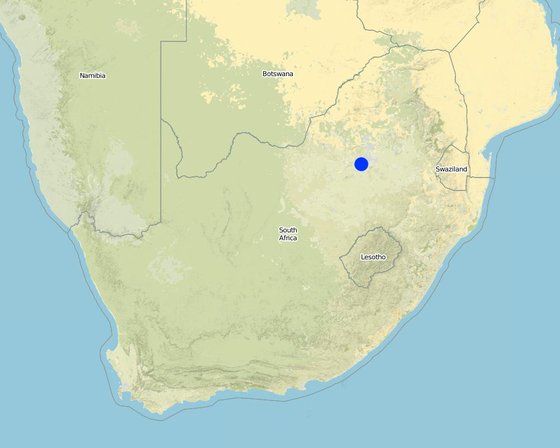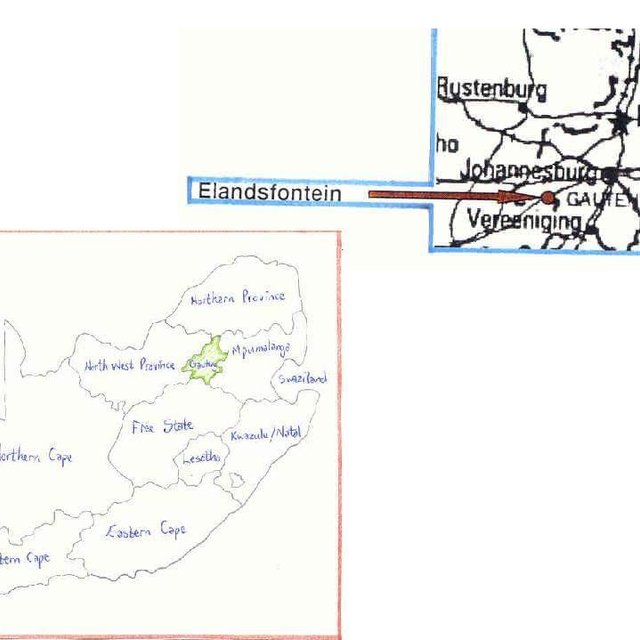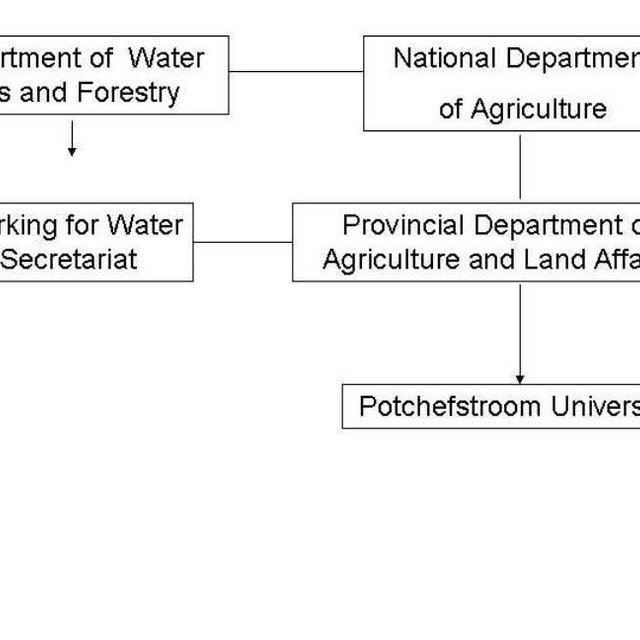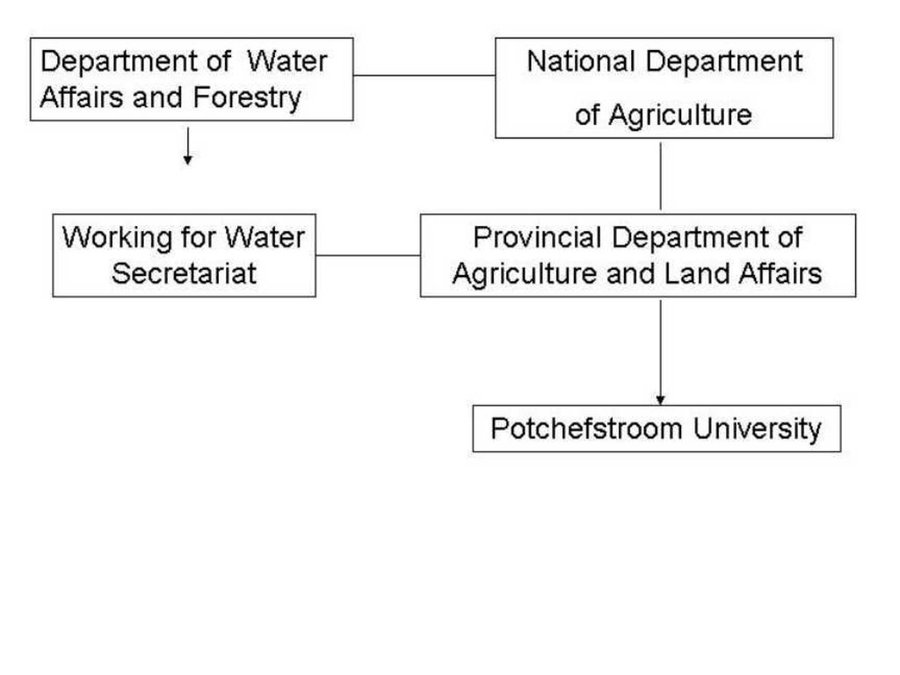Working for Water
(South Africa)
Description
Government funded restoration/rehabilitation initiative as part of Working for Water project. Aim was to eradicate alien invasive.
Aims / objectives: The aim was to eradicate alien invasive species and then to revegetate the area in order to recover the natural grazing for livestock. Community participation plays a very important role, making them aware of the importance of restoring degraded rangelands. The approach for applying SWC technologies included making use of community members (at a daily wage) to carry out the labour intensive technologies and thus also playing a part in increasing community awareness.
Location

Location: Gauteng, South Africa
Geo-reference of selected sites
Initiation date: 1996
Year of termination: 2000
Type of Approach
-
traditional/ indigenous
-
recent local initiative/ innovative
-
project/ programme based

Map

Actors in approach
Approach aims and enabling environment
Main aims / objectives of the approach
The Approach focused mainly on SLM with other activities (Job creation and capacity building of SWC technicians. Improvement of grazing and vegetation cover, in order to conserve soil and water.)
On-site or on-farm technology application, thus making community aware of positive effect of restoration technology. To see to it that job creation occurs in surrounding communities.
The SLM Approach addressed the following problems: The evaluation of a restoration trail after the control of alien woody invasive vegetation in the Gauteng Province and to restore degraded rangeland to nearest original state before degradation took place (= improve grazing).
Conditions enabling the implementation of the Technology/ ies applied under the Approach
-
Legal framework (land tenure, land and water use rights): The existing land ownership, land use rights / water rights helped a little the approach implementation: Land users did not liked what happened, do not think the approach will work. Some appreciation for what is being done.
Conditions hindering the implementation of the Technology/ ies applied under the Approach
-
Availability/ access to financial resources and services: No funds available for restoration.
Treatment through the SLM Approach: Apply more cost effective approaches or apply for funds.
-
Knowledge about SLM, access to technical support: Equipment used is too labour intensive and take a lot of time.
Treatment through the SLM Approach: If enough funds were available, mechanical equipment could be used (faster and more effective).
-
Other: Involvement of community.
Treatment through the SLM Approach: Negotiation and awareness programmes.
Participation and roles of stakeholders involved
Stakeholders involved in the Approach and their roles
| What stakeholders / implementing bodies were involved in the Approach? |
Specify stakeholders |
Describe roles of stakeholders |
| local land users/ local communities |
Working land users were work equally divided between men and women (Volunteers from communities for |
|
| national government (planners, decision-makers) |
DAF and Provincial Department of Agriculture (initiative an |
|
| international organization |
|
Funding |
Involvement of local land users/ local communities in the different phases of the Approach
none
passive
external support
interactive
self-mobilization
implementation
Mainly: responsibility for major steps; partly: casual labour
Flow chart
Actors in approach
Decision-making on the selection of SLM Technology
Decisions were taken by
-
land users alone (self-initiative)
-
mainly land users, supported by SLM specialists
-
all relevant actors, as part of a participatory approach
-
mainly SLM specialists, following consultation with land users
-
SLM specialists alone
-
politicians/ leaders
Decisions were made based on
-
evaluation of well-documented SLM knowledge (evidence-based decision-making)
-
research findings
-
personal experience and opinions (undocumented)
Technical support, capacity building, and knowledge management
The following activities or services have been part of the approach
-
Capacity building/ training
-
Advisory service
-
Institution strengthening (organizational development)
-
Monitoring and evaluation
-
Research
Capacity building/ training
Training was provided to the following stakeholders
-
land users
-
field staff/ advisers
-
SWC specialists, extensionists/trainers
Form of training
-
on-the-job
-
farmer-to-farmer
-
demonstration areas
-
public meetings
-
courses
Subjects covered
Ecological principles, restoration technologies.
Advisory service
Advisory service was provided
-
on land users' fields
-
at permanent centres
Name of method used for advisory service: Demonstration; Key elements: Rural community appraisal, participatory rural approach; 1) Advisory service was carried out through: government's existing extension system. Extension staff: specifically hired project employees 3) Target groups for extension: technicians/SWC specialists; Activities: People in charge of field work etc.
Advisory service is inadequate to ensure the continuation of land conservation activities; Except for being inadequate, there are not enough funds available to continue the activities. Expert advise from specialists after evaluation is also needed to be adequate.
Institution strengthening
Institutions have been strengthened / established
-
no
-
yes, a little
-
yes, moderately
-
yes, greatly
Describe institution, roles and responsibilities, members, etc.
Type of support
-
financial
-
capacity building/ training
-
equipment
Further details
Monitoring and evaluation
bio-physical aspects were regular monitored through measurements
economic / production aspects were ad hoc monitored through observations
area treated aspects were regular monitored through measurements
no. of land users involved aspects were ad hoc monitored through observations
management of Approach aspects were ad hoc monitored through observations
There were no changes in the Approach as a result of monitoring and evaluation: One site establishment for restoration purposes, thus no changes where made because no future project is planned in area in near future.
Research
Research treated the following topics
-
sociology
-
economics / marketing
-
ecology
-
technology
Soil related research and analyses and also restoration technology application information.
Research was carried out on-farm
Financing and external material support
Annual budget in USD for the SLM component
-
< 2,000
-
2,000-10,000
-
10,000-100,000
-
100,000-1,000,000
-
> 1,000,000
Precise annual budget: n.a.
Approach costs were met by the following donors: international (Donors): 10.0%; government (national - Water Affairs (DAF)): 80.0%; national non-government (University): 10.0%
The following services or incentives have been provided to land users
-
Financial/ material support provided to land users
-
Subsidies for specific inputs
-
Credit
-
Other incentives or instruments
Financial/ material support provided to land users
partly financed
fully financed
equipment: machinery: tools
agricultural: seeds: fertilizers
Labour by land users was
-
voluntary
-
food-for-work
-
paid in cash
-
rewarded with other material support
Impact analysis and concluding statements
Impacts of the Approach
No
Yes, little
Yes, moderately
Yes, greatly
Did the Approach help land users to implement and maintain SLM Technologies?
To layout contours to prevent erosion and serve as catchment for water. Establishment of grass also served as stabiliser to prevent erosion and also serves as fodder in addition.
Did other land users / projects adopt the Approach?
Unsure.
Main motivation of land users to implement SLM
Sustainability of Approach activities
Can the land users sustain what hat been implemented through the Approach (without external support)?
Most land users benefited from the approach and they are either in direct vicinity or were part of the job creation. They know the benefit of the results from restoration obtained and this might have inspired them to carry on. If some funds were to be available (from the land users themselves) they might be able to continue the approach by themselves and they know they will benefit from it.
Conclusions and lessons learnt
Strengths: land user's view
-
Job creation. (How to sustain/ enhance this strength: Appoint members could involve rest of community to help look after restored area (improved grazing).)
-
Training. (How to sustain/ enhance this strength: Community members learnt a lot about conservation and they can now carry on with it on their own (they have the knowledge).)
Strengths: compiler’s or other key resource person’s view
-
Job creation. (How to sustain/ enhance this strength: Appoint a community member to look after the area and see that if is managed.)
-
Awareness and training. (How to sustain/ enhance this strength: Personal improvement to understand how to take care of land and how to improve it.)
-
Inter-cultural co-operation.
Weaknesses/ disadvantages/ risks: land user's viewhow to overcome
Weaknesses/ disadvantages/ risks: compiler’s or other key resource person’s viewhow to overcome
-
Not enough communication between specialists and community members on important factors.
Better communication from start of approach or project.
-
Linguistic abilities not sufficient (especially on side of specialists).
To obtain some simple linguistic abilities, such as how to greet and ask approach related questions.
-
SWC technology application must not be built on job creation incentives (only), but must be sustainable in the long term without incentives (job creations) by the land users.
References
Date of documentation: Jan. 14, 2009
Last update: June 18, 2017
Resource persons
-
Anuschka Barac - SLM specialist
-
Klaus Kellner (klaus.kellner@nwu.ac.za) - SLM specialist
-
Sarone de Wet - SLM specialist
-
Erich Fulls - SLM specialist
-
Edward Lepin - SLM specialist
Full description in the WOCAT database
Documentation was faciliated by
Institution
- Gauteng Department of Agriculture and Rural Develo (Gauteng Department of Agriculture and Rural Develo) - South Africa
- Georg August Universität Göttingen (Georg August Universität Göttingen) - Germany
- Potchefstroom Universiteit vir CHO (Potchefstroom Universiteit vir CHO) - South Africa
Project







